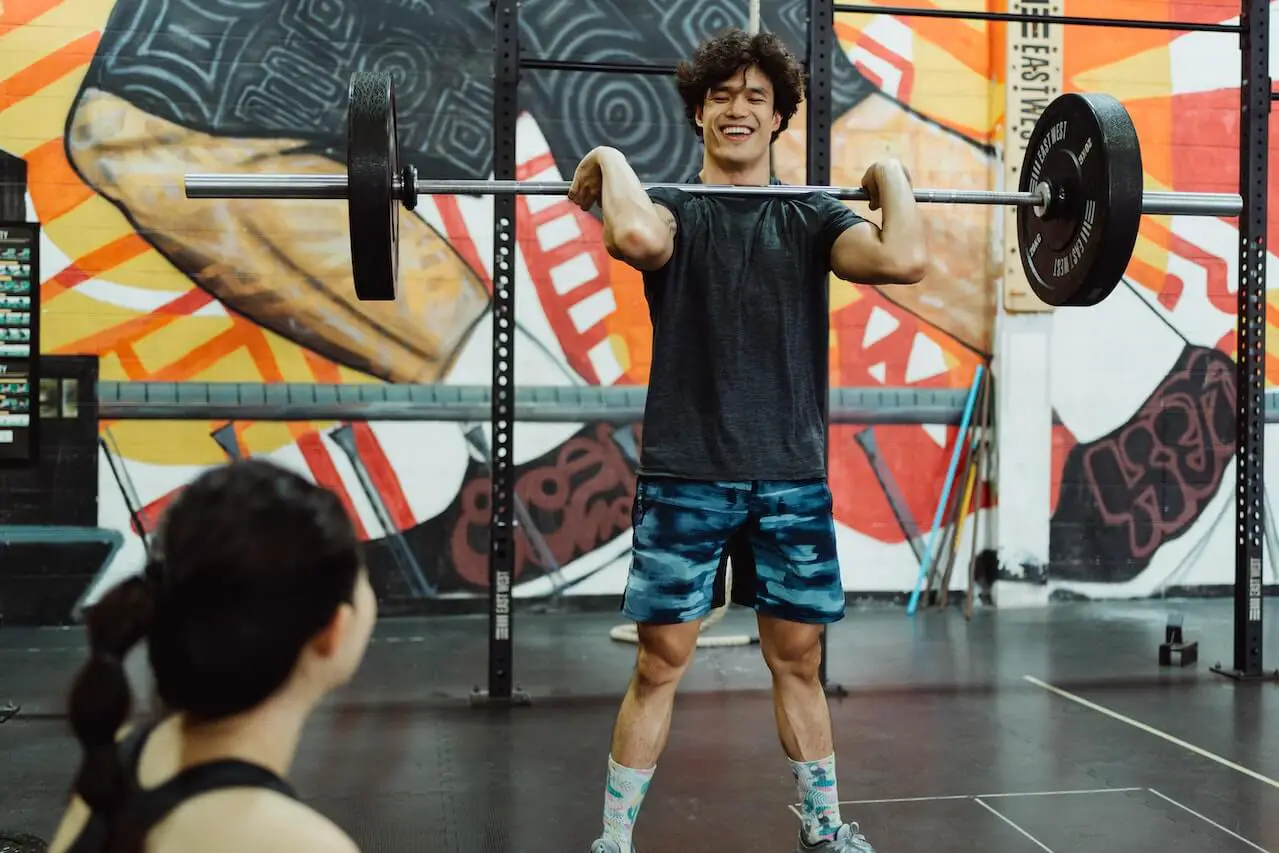Swimming requires strength, endurance, and technique to excel and compete at a high level. One exercise that can improve a swimmer’s strength and endurance is the clean.

Cleans are a compound exercise that helps to develop explosive strength and muscle coordination. By incorporating cleans into your swim training, you can simultaneously strengthen your lower body, upper body, and core muscles, which are essential for an efficient and powerful swimming stroke. Additionally, this exercise can improve your posture, ultimately enhancing your swimming technique.
Keep reading on to learn how integrating this full-body movement into your swim training can help increase your overall strength and power in the water.
Why Cleans Are Beneficial for Swimmers
Strength and Conditioning Benefits
Cleans are an excellent strength and conditioning exercise for swimmers like you. They target major muscle groups such as your glutes, hamstrings, and lower back, helping you to develop a strong foundation for more powerful swimming strokes.
When you incorporate cleans into your training routine, you’re working on the muscles needed for a more efficient pull in the water, enabling you to glide through the water with increased ease and strength.
Improving Explosiveness and Athletic Performance
If you want to improve your overall athletic performance in the water, cleans can be your go-to exercise. By focusing on explosive movements, you’ll enhance your muscle power and speed.
As a result, you can push off the walls, dive into the water, and accelerate during your swimming with more force, ultimately allowing you to outpace your competition.
Improving Core Strength
A strong core is essential for maintaining proper body alignment and navigating through the water efficiently. Cleans target your core muscles, including your abs and lower back, helping to boost muscle development and stabilize your torso.
The stronger your core, the better you can control and maintain your body position during swimming, leading to better technique and reduced drag in the water.
Developing Full Body Coordination
Swimming requires the coordination of multiple muscle groups working together in harmony. Cleans teach your body to coordinate your movements as one efficient, powerful unit.
By incorporating cleans into your training regimen, you’ll develop full-body coordination, ultimately translating into a more streamlined, powerful swimming technique.
Foundational Exercises for the Clean
Before you start with cleans, you should familiarize yourself with the basic movements involved in the exercise.
This section can serve as a preview of how technical the clean is, since you need to first be familiar with three exercises – deadlift, front squat, and high pull – which are very technical as well.
The clean goes through the same motions as all three of these exercises, so being proficient in them will make learning the clean much easier.
If you are already comfortable with these exercises, then you can skip this section. Otherwise, let’s begin, starting with the deadlift.
The Deadlift
The deadlift is foundational to the clean as it mimics the first pull of the movement.
Steps:
- Stand with feet hip-width apart, with the barbell over the mid-foot.
- Bend at your hips and knees to grip the barbell with hands shoulder-width apart.
- Keeping your back straight, push through your heels to stand up straight and lift the barbell.
- Reverse the movement to return the barbell to the ground.
The Front Squat
Cleans end with a front squat position, so getting comfortable with this movement is crucial.
Steps:
- Start by standing tall with a barbell resting on your front shoulders.
- Keeping your chest up, lower your body by pushing your hips back and bending your knees.
- Push back up to the starting position.
The High Pull
This movement helps with the transition from the pull to the catch phase of the clean.
Steps:
- Begin in the same position as the deadlift.
- Pull the barbell up, driving your elbows high and to the side.
- Lower the barbell back to the starting position.
Learning the Clean
Once you are comfortable with the basic movements, you can incorporate their movements into the clean.
The Set-Up
- Start in the same position as a deadlift.
- Grip the barbell with hands just outside of your knees.
- Make sure your back is straight and chest is up.
The First Pull
- Push through your heels to lift the barbell off the floor.
- Keep the barbell close to your body and continue to lift it until it reaches the top of your knees.
The Second Pull
- Extend your hips and knees rapidly to lift the barbell higher.
- Shrug your shoulders and pull the barbell up to your chest.
- Keep the barbell close to your body during this movement.
The Catch
- Once the barbell reaches its highest point, quickly drop into a quarter squat position.
- Catch the barbell on the front of your shoulders.
- Stand up fully, ending in the same position as a front squat.
Incorporating Cleans into Swim Training

Progressing with Cleans
To start, focus on mastering the starting position by standing with your feet slightly wider than shoulder-width apart and the barbell just in front of your shins. Beginners should practice the movement without weight to build proper form and coordination.
Gradual Weight Increases
As your form and confidence improve, start to gradually increase the weight you’re lifting. It’s important to prioritize good form over lifting heavier weights. If your form starts to break down, reduce the weight.
Frequent Practice
Cleans are a technical lift that require frequent practice to master. Include them in your workout routine 2-3 times per week.
Professional Guidance
There’s only so much information that can be conveyed through text or video; there’s no shame in working with a professional trainer who specializes in Olympic lifting one-on-one, in-person, for specialized advice and feedback. They can help you progress faster and more safely.
Effective Variations for Swimmers
Swimmers can benefit from a few variations to the standard power clean.
The hang clean focuses more on upper body explosiveness and reduces the load on your legs. This technique may be helpful for improving turns and underwater kicks.
Another useful modification is the squat clean, which involves catching the bar in a squat position. This can help develop lower body strength, flexibility, and stability, all essential for strong swimming performance.
Determining the Right Repetition and Load
To maximize the benefits of power cleans for swimming, you must select the appropriate load and repetition. That number is different for everyone, but err on the side of caution and pick a weight on the lighter side that you feel comfortable with. Ego-lifting will only lead to injury.
Aim for 3 to 5 sets of 3 to 6 repetitions, focusing on speed and explosiveness rather than heavy weight or significant training volume. If you’re still not comfortable with the movement, then definitely stick to a lighter weight or even just the bar and practice the motions.
The optimal weight will challenge your muscles but not excessively fatigue them. Perform power cleans at least twice a week, but avoid them on days when you have intense swim sessions to prevent overtraining.
Balancing Power Cleans with Other Exercises
Incorporating complementary exercises can enhance the effectiveness of power cleans in your swim training.
Compound exercises like deadlifts, pull-ups, and front squats work multiple muscle groups and should be included in your strength and conditioning program.
Don’t neglect core training and flexibility, as these are vital for maintaining proper form and ensuring joint health.
Swimming-specific exercises like lat pull-downs, chest flys, and glute bridges can further support athletic performance in the water.
Addressing Mobility Issues
Mobility can be a common hurdle for many athletes, including swimmers. Power cleans target various muscle groups, from your core and lower body to your upper back and shoulders. Thus, addressing mobility issues is essential to ensure an effective and injury-free workout.
Perform dynamic stretches, mobility exercises, and foam rolling to improve your flexibility and range of motion, particularly in your ankles, hips, and shoulders.
Additionally, incorporating modifications like the hang power clean and practicing the Olympic lifts, like the snatch and overhead press, can help enhance your coordination and increase your muscle growth.
Don’t rush the learning process and consult a professional if necessary to refine your technique.
By paying attention to proper form, addressing mobility issues, and following safe practices, you’ll make power cleans a valuable addition to your swim training routine, boosting your core strength, overall posture, and performance.
Sources:
- https://journals.lww.com/nsca-scj/Fulltext/2010/08000/Why_Competitive_Swimmers_Need_Explosive_Power.9.aspx
- https://www.healthline.com/health/fitness/power-clean
- https://barbend.com/power-clean
- https://www.stack.com/a/power-clean-mistakes
- https://thegymgoat.com/power-clean-benefits/
- https://strengthambassadors.com/blog/the-7-reasons-why-you-should-power-clean/

